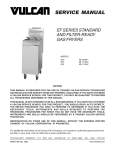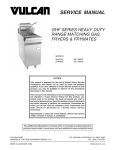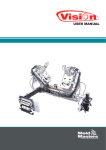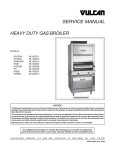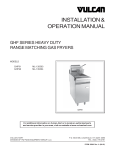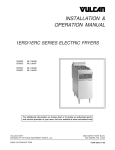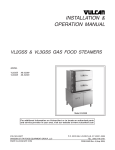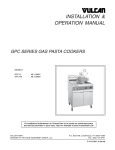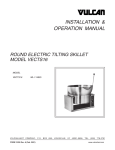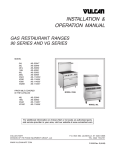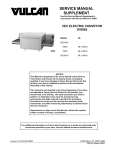Download Vulcan-Hart 1GR45MF ML-136785 Service manual
Transcript
SERVICE MANUAL EF SERIES GAS FRYERS MODELS EF3 EF4 EF5 ML-52099 ML-114943 ML-114944 - NOTICE This manual is prepared for the use of trained Vulcan Service Technicians and should not be used by those not properly qualified. If you have attended a Vulcan Service School for this product, you may be qualified to perform all the procedures described in this manual. This manual is not intended to be all encompassing. If you have not attended a Vulcan Service School for this product, you should read, in it's entirety, the repair procedure you wish to perform to determine if you have the necessary tools, instruments and skills required to perform the procedure. Procedures for which you do not have the necessary tools, instruments and skills should be performed by a trained Vulcan Service Technician. Reproduction or other use of this Manual, without the express written consent of Vulcan, is prohibited. For additional information on Vulcan-Hart or to locate an authorized parts and service provider in your area, visit our website at www.vulcanhart.com VULCAN-HART DIVISION OF ITW FOOD EQUIPMENT GROUP, LLC P.O. BOX 696, LOUISVILLE, KY 40201-0696 TEL. (502) 778-2791 WWW.VULCANHART.COM F-35641 (2-05) EF SERIES GAS FRYERS CONTENTS GENERAL .......................................................................................................................................... 3 INTRODUCTION ........................................................................................................................ 3 Models ................................................................................................................................ 3 INSTALLATION .......................................................................................................................... 3 OIL FILTERING .......................................................................................................................... 3 OPERATION .............................................................................................................................. 3 CLEANING ................................................................................................................................. 3 LIGHTING PILOT ....................................................................................................................... 3 SPECIFICATIONS ..................................................................................................................... 3 Gas Data ............................................................................................................................ 3 TOOLS ....................................................................................................................................... 3 Standard ............................................................................................................................. 3 REMOVAL AND REPLACEMENT OF PARTS .................................................................................. 4 COVERS AND PANELS ............................................................................................................ 4 Door .................................................................................................................................... 4 Heat Shield ......................................................................................................................... 4 BURNERS .................................................................................................................................. 5 THERMOSTAT ........................................................................................................................... 5 HIGH LIMIT ................................................................................................................................ 7 THERMOPILE ............................................................................................................................ 8 PILOT ORIFICE ......................................................................................................................... 9 PILOT ......................................................................................................................................... 9 COMBINATION VALVE ............................................................................................................ 10 FRY TANK ................................................................................................................................. 11 SERVICE PROCEDURES AND ADJUSTMENTS ........................................................................... 12 MILLIVOLT CONTROLS TEST ................................................................................................ 12 THERMOSTAT CALIBRATION ................................................................................................ 12 Calibration Steps .............................................................................................................. 12 PILOT ADJUSTMENT .............................................................................................................. 13 BURNERS, NOZZLES AND ORIFICES .................................................................................. 13 Burners ............................................................................................................................. 13 Nozzles and Orifices ........................................................................................................ 13 COMBINATION VALVE REGULATOR ADJUSTMENT ............................................................ 14 ELECTRICAL OPERATION ............................................................................................................. 16 CONTROL SYSTEM DESCRIPTION ...................................................................................... 16 SYSTEM CONDITION QUICK CHECK PROCEDURES ......................................................... 17 SCHEMATIC ............................................................................................................................ 17 COMPONENT FUNCTION ...................................................................................................... 17 TROUBLESHOOTING ..................................................................................................................... 18 F35641 (02-05) —2— EF SERIES GAS FRYERS GENERAL 4. While still holding knob in light the pilot with a taper. Continue to depress knob (approximately 30 seconds) until the pilot remains lit after the knob is released. If pilot does not remain lit, repeat steps 2, 3 & 4. INTRODUCTION Models This service manual was written for: EF3, EF4 and EF5 Gas Fryers. 5. Turn gas control valve knob to ON. 6. If gas supply is interrupted, repeat steps 1-5. INSTALLATION Generally, installations are made by the dealer or contracted by the dealer or owner. Detailed installation instructions are included in the Installation and Operation Manual, which is sent with each fryer. SPECIFICATIONS Gas Data OIL FILTERING Filtering instructions are included in the Installation and Operation Manual. MODEL NO. TUBES BTU/HR EF3 EF4 EF5 3 4 5 90,000 120,000 150,000 TOOLS OPERATION Detailed operation instructions are included with each fryer in the Installation and Operation Manual. Standard CLEANING Detailed cleaning procedures are included in the Installation and Operation Manual. LIGHTING PILOT • Hand tools (standard set) • VOM with AC current tester (any quality VOM with a sensitivity of at least 29,000 ohms per volt can be used) • Gas test kit • Temperature tester (thermocouple type) • Manometer 1. Turn thermostat OFF. 2. Turn gas control valve knob to OFF/PILOT. Wait 5 minutes. 3. Push the gas control valve knob in. —3— F35641 (02-05) EF SERIES GAS FRYERS REMOVAL AND REPLACEMENT OF PARTS Heat Shield COVERS AND PANELS 1. Remove screws holding heat shield in place (Figure 2). WARNING: SHUT OFF THE GAS BEFORE SERVICING. Door 1. While holding onto the door remove (2) screws securing the door hinge to the fryer bottom front flange (Figure 1). Figure 2 Figure 1 2. Remove heat shield. 2. Prepare to catch door assembly. Once screws and hinge are removed, the door will drop off into your hand(s). 3. Reinstall door assembly by reversing steps 1 & 2 above. F35641 (02-05) —4— EF SERIES GAS FRYERS BURNERS WARNING: SHUT OFF THE GAS BEFORE SERVICING. 1. Remove heat shield as outlined under Cover and Panels. (Optional) 2. Loosen the two mounting bolts at the top of each burner (Figure 3). Figure 4 4. Reverse the procedure to install. THERMOSTAT WARNING: SHUT OFF THE GAS BEFORE SERVICING. 1. Drain shortening from fry tank. 2. Remove heat shield as outlined under Covers and Panels. Figure 3 3. Push burner up while pulling the bottom of the burner forward to clear the burner nozzle (Figure 4). 3. Remove left burner as outlined under Burners. 4. Remove thermostat knob by pulling knob off thermostat shaft. —5— F35641 (02-05) EF SERIES GAS FRYERS 7. Loosen the packing nut and holding nut (Figure 7). 5. Remove thermostat mounting screws and remove thermostat from mounting bracket (Figure 5). Figure 7 8. Remove the thermostat bulb from the clamp (Figure 8). Figure 5 6. Remove wire leads from the rear of the thermostat, noting all connections for reassembly (Figure 6). Figure 8 9. Pull the thermostat bulb through the underside of the fry tank and remove the thermostat assembly. Figure 6 F35641 (02-05) —6— EF SERIES GAS FRYERS 6. Loosen the packing nut and the holding nut (Figure 10). 10. Reverse the procedure to install. When installing the new thermostat assembly, do not kink the thermostat capillary. Wrap threads of packing nut with Teflon tape to prevent leakage. HIGH LIMIT WARNING: SHUT OFF THE GAS BEFORE SERVICING. 1. Drain shortening from fry tank. 2. Remove heat shield as outlined under Covers and Panels. 3. Remove wire leads from high limit, noting all connections for reassembly (Figure 9). Figure 10 7. Remove the high limit bulb from the clamp (Figure 11). Figure 9 4. Remove high limit from mounting bracket. 5. Remove left burner as outlined under Burners. Figure 11 —7— F35641 (02-05) EF SERIES GAS FRYERS 8. Pull the high limit bulb through the underside of the fry tank and remove the high limit. 9. Reverse the procedure to install. When installing the new high limit assembly, do not kink the high limit capillary. Wrap threads of packing nut with Teflon tape to prevent leakage. THERMOPILE WARNING: SHUT OFF THE GAS BEFORE SERVICING. WARNING: ALL GAS JOINTS DISTURBED DURING SERVICING MUST BE CHECKED FOR LEAKS. CHECK WITH SOAP AND WATER SOLUTION (BUBBLES). DO NOT USE AN OPEN FLAME. 1. Remove the screw securing the Pilot/ Thermopile Assembly Bracket to the tank front. Lower the assembly away from the tank (Figure 12). 2. Disconnect thermopile lead wires as outlined under High Limit. Figure 12 F35641 (02-05) —8— EF SERIES GAS FRYERS 3. Remove thermopile from pilot bracket by loosening the holding nut (Figure 13). PILOT WARNING: SHUT OFF THE GAS BEFORE SERVICING. WARNING: ALL GAS JOINTS DISTURBED DURING SERVICING MUST BE CHECKED FOR LEAKS. CHECK WITH SOAP AND WATER SOLUTION (BUBBLES). DO NOT USE AN OPEN FLAME. 1. Remove the screw securing the Pilot/ Thermopile Assembly Bracket to the tank front. Lower the assembly away from the tank (Figure 12). 2. While holding assembly in the palm of your hand remove the pilot compression fitting at the bottom of the pilot and disconnect the pilot tubing (Figure 12). Figure 13 3. Remove thermopile as outlined under Thermopile (set aside for reassembly). 4. Reverse procedure to install. 4. Remove (2) screws holding the pilot assembly to the Pilot/Thermopile Assembly Bracket and replace the old pilot with the new assembly (Figure14). PILOT ORIFICE WARNING: SHUT OFF THE GAS BEFORE SERVICING. WARNING: ALL GAS JOINTS DISTURBED DURING SERVICING MUST BE CHECKED FOR LEAKS. CHECK WITH SOAP AND WATER SOLUTION (BUBBLES). DO NOT USE AN OPEN FLAME. 1. Remove the screw securing the Pilot/ Thermopile Assembly Bracket to the tank front. Lower the assembly away from the tank (Figure 12). 2. While holding assembly in the palm of your hand remove the pilot compression fitting at the bottom of the pilot to expose the orifice (Figure 12). 3. Replace orifice and reverse procedure to assemble. Figure 14 5. Reinstall by reversing steps 1-4. —9— F35641 (02-05) EF SERIES GAS FRYERS 6. Disconnect combination valve union and pressure fitting (Figure 16). COMBINATION VALVE WARNING: SHUT OFF THE GAS BEFORE SERVICING. WARNING: ALL GAS JOINTS DISTURBED DURING SERVICING MUST BE CHECKED FOR LEAKS. CHECK WITH SOAP AND WATER SOLUTION (BUBBLES). DO NOT USE AN OPEN FLAME. 1. Disconnect fryer from main gas supply. 2. Remove heat shield as outlined under Covers and Panels. (Optional) 3. Remove right burner as outlined under Burners. 4. Disconnect wire leads from the combination valve and mark for reconnecting. 5. Disconnect pilot tubing from combination valve (Figure 15). Figure 16 7. Remove the combination valve from the fryer. 8. Remove all pipe fittings from the old combination valve if the new valve is not supplied with fittings. 9. Reverse procedure to install using original pipe fittings. Figure 15 F35641 (02-05) — 10 — EF SERIES GAS FRYERS 7. Remove the manifold bracket from the tank assembly by removing the (4) bolts (Figure 18). FRY TANK WARNING: SHUT OFF THE GAS BEFORE SERVICING. WARNING: ALL GAS JOINTS DISTURBED DURING SERVICING MUST BE CHECKED FOR LEAKS. CHECK WITH SOAP AND WATER SOLUTION (BUBBLES). DO NOT USE AN OPEN FLAME. 1. Disconnect fryer from main gas supply. 2. Remove baskets, fryer basket hanger and crumb screen. 3. Drain oil from tank. 4. Remove heat shield as outlined under Covers and Panels. Figure 18 5. Remove screws holding fryer tank (Figure 17). 8. Remove thermostat and high limit as outlined under Thermostat and High Limit. 9. Remove the screw securing the Pilot/ Thermopile Bracket Assembly (Figure 19). Figure 17 6. Remove burners as outlined under Burners. Figure 19 10. Lift the fry tank up and out of cabinet. Carefully place the tank assembly on the floor (this procedure requires two people). 11. Remove the tank ball drain valve (Figure 18). 12. Reverse the procedure to install new tank. — 11 — F35641 (02-05) EF SERIES GAS FRYERS SERVICE PROCEDURES AND ADJUSTMENTS MILLIVOLT CONTROLS TEST 1. Verify proper gas (natural or propane) is present. 7. Turn gas control valve knob to ON. Turn thermostat to a setting higher than the shortening temperature. A. If the voltage measures 150 millivolts or more but the burners do not ignite, replace the combination valve. 2. Check for correct wiring and secure connections. B. If the voltage is less than 150 millivolts, measure the voltage between terminals NO of the high limit and PG of the combination valve. 3. Verify the pilot flame is adjusted properly as outlined in Pilot Adjustment. 4. If the pilot is not lit, light pilot as outlined under Lighting Pilot. Allow the pilot to burn for 3 to 4 minutes to stabilize. 1) If the voltage is 200 millivolts or greater, replace the thermostat. A. If the pilot remains lit, proceed to step 6. 2) If the voltage is less than 200 millivolts, replace the combination valve. B. If the pilot will not remain lit, proceed to step 5. 5. Connect DC voltmeter to terminals TH-PG and PG of combination valve. Relight the pilot, hold the gas control valve knob in and allow the pilot to burn for 3 to 4 minutes to stabilize. A. lf the voltage measures 450 millivolts or greater and the pilot will not stay lit, replace the combination valve. B. lf the voltage is less than 450 millivolts, measure the voltage at terminals NO and C of high limit. THERMOSTAT CALIBRATION 1. Place temperature tester in the fry tank near the thermostat bulb. 2. Set the thermostat to 300°F and allow the temperature to stabilize. 3. Check the temperature tester reading against the thermostat dial reading. If there is a variance of more than ±20°F (280°F to 320°F), calibration is required. 1) If the voltage is 500 millivolts or more, replace the high limit. Calibration Steps 2) If the voltage is less than 500 millivolts, disconnect the lead wire from terminal TH-PG of the combination valve and remeasure voltage at the high limit. 1. Remove thermostat knob from shaft. a. If the voltage is less than 500 millivolts, replace the thermopile. b. If the voltage is 500 millivolts or more, replace the combination valve. 6. Connect DC voltmeter to terminals PG and TH of combination valve. F35641 (02-05) 2. Using a small screwdriver, rotate the setscrew inside the hollow shaft counterclockwise to increase the temperature or clockwise to decrease the temperature (1/4 turn equals approximately 18°F). 3. Allow temperature to stabilize and recheck temperature. Repeat until the temperature falls within the limits as stated in step 3 under Thermostat Calibration. 4. Install thermostat knob and set dial to 350° — 12 — EF SERIES GAS FRYERS 5. Allow temperature to stabilize at new setting and compare temperature tester to dial setting. Recalibrate if the temperature does not fall within the range of 330°F to 370°F. 6. If the temperature does not fall within the limits at both settings, replace the thermostat. PILOT ADJUSTMENT 1. Light pilot as outlined under Lighting Pilot. Figure 21 2. If the flame does not extend beyond the outer edges of the pilot shield 1/2”, or extends more than 1/2”, (Figure 20), an adjustment is necessary. BURNERS, NOZZLES AND ORIFICES WARNING: SHUT OFF THE GAS BEFORE SERVICING. Burners If the burner ports become clogged, the fryer will not operate properly. If the burner is cracked, it must be replaced. 1. Remove burner(s) as outlined under Burners. 2. Check burner(s) for cracks and clogged ports. Figure 20 3. Remove the cap covering pilot adjustment screw, (Figure 21). Turn the recessed pilot adjustment screw counterclockwise to increase the size of the flame or clockwise to decrease the size of the flame. 3. If the ports are clogged, wash burner(s) in warm, soapy water. If this does not remove obstructions, a #37 drill bit can be used (do not use in an electric drill; hand-turn only). Nozzles and Orifices 1. Remove the burners as outlined under Burners. — 13 — F35641 (02-05) EF SERIES GAS FRYERS 2. Hold the burner nozzle with channel locks and remove the orifice, (Figure 22). Check the orifice for obstructions or damage. 1. Turn the gas control valve knob to OFF (Figure 23). Figure 23 2. Remove the plug from the submanifold and install pressure gauge at this point (Figure 24). Figure 22 3. If the orifice is clogged, wash the orifice in warm, soapy water. If this does not remove obstructions, a #37 drill bit can be used (do not use in an electric drill; hand-turn only). 4. With channel locks, remove the burner nozzle (Figure 22). 5. Reverse procedure to install new burner nozzle and orifice. COMBINATION VALVE REGULATOR ADJUSTMENT WARNING: SHUT OFF THE GAS BEFORE SERVICING. Accurate gas pressure adjustments can only be made with the gas on and the burner lit. If the incoming line pressure to the valve is less than the minimum stated, then the pressure cannot be set correctly. Figure 24 3. Turn on the gas and light the pilot as outlined under Lighting Pilot. 4. Turn the gas control valve knob to ON. 5. Set the thermostat so the burners will come on. The combination valve is preadjusted for natural or propane gas as specified on the rating plate. The natural gas rating is 4” W.C., and the propane rating is 10" W.C. F35641 (02-05) — 14 — EF SERIES GAS FRYERS 6. Read the pressure gauge. The manifold pressure reading should match the pressure rating on the data plate. A. To adjust, remove the cap covering the manifold pressure adjustment screw (Figure 25). Turn the recessed manifold pressure adjustment screw counterclockwise to decrease pressure or clockwise to increase pressure. Figure 25 7. Install the cap and check for proper operation. — 15 — F35641 (02-05) EF SERIES GAS FRYERS ELECTRICAL OPERATION C. When the thermostat calls for heat (closed circuit) power from the thermopile is then connected to the other combination valve thermostat connection through wire 2. CONTROL SYSTEM DESCRIPTION 1. The thermopile (PG) provides the total control voltage for this system. D. If the high limit trips, the thermopile is connected across zero ohms, the output voltage of the thermopile drops to 0.0 millivolts, and the thermostat coil of the combination valve drops out, shutting the thermostat valve. A. One side of the thermopile is connected to the common (C) of the high limit (HL). B. The other side of the thermopile is connected to the normally open (NO) contacts of the high limit. 3. Total Shutdown. C. The common of the high limit (below the high limit trip temp.) is connected through the normally closed (NC) contacts of the high limit, through wire 3 to the combination valve pilot connection common. D. The other side of the pilot valve is connected through wire 4 to wire 1 to the high limit normally open contacts which hold the pilot valve open. 1) If the high limit trips, connection is made from the common to the normally open contacts, turning off pilot valve voltage. The gas valve closes. 2. Thermostat Control. A. One side of the millivolt supply is connected through the high limit system, as described above, to the thermostat common (wire 3) of the combination valve. B. The other side of the thermopile is connected from the normally open contacts of the high limit to the thermostat through wire 1. F35641 (02-05) — 16 — A. When the high limit trips, 0.0 millivolts will read across both coils of the combination valve, causing both valves to close. B. Pilot relight cannot be accomplished until oil cools sufficiently to allow high limit to close. C If any wire in the system is cut or broken, the system will shut down. EF SERIES GAS FRYERS SYSTEM CONDITION QUICK CHECK PROCEDURES SCHEMATIC 1. Use the Pilot Lighting procedure and check millivolts (mV) at wires 3 and 4. A. lf the pilot lights, then pilot combination valve and high limit are good. B. If the pilot will not stay lit, check high limit and open the thermopile circuit. It should read 300 mV; if there are Ø volts, check high limit. If the high limit is good, replace combination valve. C. Check for voltage at disconnected thermopile. It should read 300 mV; if there are Ø volts, replace thermopile. Check high limit. If the high limit is good, replace combination valve. 2. Turn on thermostat; burners should light. A. lf the burner does not light, check the following: 1) Voltage at combination valve at wires 2 and 4. Figure 26 2) If correct voltage is present, then check combination valve. 3) If there are Ø volts, check voltage between wire 3 of combination valve and wire 1 of thermostat. If correct voltage is present, then check resistance of the thermostat contacts and continuity of wires 3 & 2. COMPONENT FUNCTION • Thermostat - Millivolt type with capillary bulb, single-throw break on temperature rise. Temperature range of 200°F to 400° F. • Thermopile - Millivolt control with 24" capillary. Rated to generate 500 millivolts. • Combination Valve - Regulates gas flow to burner and pilot. Provides pilot safety. • High Limit - Prevents overheating of fryer in the event of thermostat failure. Opens at 465°F and automatically resets at 415°F. — 17 — F35641 (02-05) EF SERIES GAS FRYERS TROUBLESHOOTING SYMPTOM The temperature of the shortening drops, or excessive recovery time is required. Pilot won’t stay lit. Fryer shuts off. Rapid shortening breakdown, crumbs and specks in frying compound. CAUSE Insufficient gas supply to unit. REMEDY Adjust gas supply at gas combination valve. Ventilation system pulling Relocate fryer. heat out of heat exchanger and flue box. Overloading fryer capacity. Malfunctioning thermopile or loose/dirty connection in thermopile. Adjust loads accordingly. Check thermopile function and connections. Adjust or replace as required. Malfunctioning shutoff valve. Replace shutoff valve. Pilot burner orifice and air openings need cleaning. Excessive temperature settings (over 375° F). Clean burner orifice and air openings as required. Adjust temperature setting. Shortening not being filtered regularly. Adjust filtering schedule. Incorrect preparation of breaded food. Do not use salt. Allow breading time to adhere to food. Do not allow loose flour to fall into shortening from hands. Do not add strainings or drippings from meat fats to shortening. Use correct shortening and follow temperature recommendations. Take out 10% to 15% of the shortening. Check thermostat settings with thermometer periodically. F35641 (02-05) — 18 — EF SERIES GAS FRYERS SYMPTOM Leaking tank. Pilot burner flames adjusted properly, but fluctuates to very low and blows out easily. CAUSE REMEDY Foam-over by depleted shortening permits oil to drip from the tank surface, giving appearance of leaking. Replace shortening. Careless draining procedures. Gas control valve knob should be in PILOT or OFF position before draining oil. Burners heating an empty tank will damage tank joints. Carbon buildup causes Clean tank surfaces. rapid attack on tank by promoting acid formulation. Gas pressure too low. Check gas pressure on submanifold fitting when fryer is in operation. Gas pressure too low at submanifold. Check other equipment attached to same gas line. Adjust gas pressure at submanifold to not less than 4.0” W.C. (natural and mixed gas) or 10.0” W.C. for propane gas. — 19 — F35641 (02-05) F35641 (02-05) PRINTED IN U.S.A.




















